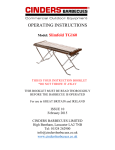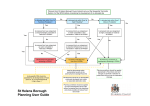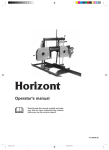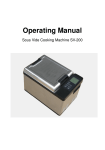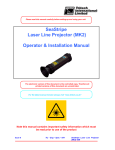Download OPERATING INSTRUCTIONS
Transcript
OPERATING INSTRUCTIONS Model: Slimfold SG80 THIS IS YOUR INSTRUCTION BOOKLET *DO NOT THROW IT AWAY THIS BOOKLET MUST BE READ THOROUGHLY BEFORE THE BARBECUE IS OPERATED For use in GREAT BRITAIN and IRELAND ISSUE 8 February 2015 CINDERS BARBECUES LIMITED High Bentham, Lancaster LA2 7NB Tel: 01524 262900 [email protected] www.cindersbarbecues.co.uk WARNINGS USE OUTDOORS ONLY (BS EN 498:2012) ACCESSIBLE PARTS MAY BE VERY HOT. KEEP YOUNG CHILDREN AND VULNERABLE ADULTS AWAY. TAKE CARE NOT TO TOUCH THE TOP OR SIDES OF THE BARBECUE AS THESE AREAS GET EXTREMELY HOT AND WILL RESULT IN BURNS. PROTECTIVE GLOVES MUST BE WORN WHEN USING THIS BARBECUE. DO NOT MOVE THE APPLIANCE WHILST IT IS ALIGHT OR IN THE HOT CONDITION. ANY MODIFICATION OF THE APPLIANCE MAY BE DANGEROUS. TURN OFF THE GAS SUPPLY AT THE CYLINDER AFTER USE. THIS APPLIANCE SHALL BE KEPT AWAY FROM FLAMMABLE MATERIALS. Information: DO NOT FIT A DOMESTIC LOW PRESSURE (37mbar) REGULATOR. This commercial appliance operates at 1bar (1000mbar) input pressure. SPECIFICATIONS DIMENSIONS: Height: 850mm. Length: 910mm. Depth: 660mm. Weight: 25Kg. GAS: PROPANE only (G31) at input pressure 1.0 bar (1000 mbar). SUPPLY CYLINDER: This barbecue is for use with propane cylinders of 13Kg (18hrs run time) or 19kg (25hrs) with L/H female screw threads connections, e.g. CALOR GAS RED CYLINDERS. REGULATOR: BS EN 16129:2013 with L/H male screw thread and brass ‘bullnose’ connection. Output pressure 1.0bar (1000mbar). HOSE: BS EN 3212 pt 2 Maximum service life 5 Years. Approved length 1.0m (1000mm). HEAT INPUT Heat input = 10.0kw (725g/hr propane) INJECTOR SIZE 60 cc (orifice 0.7mm) APPLIANCE CATEGORY. Appliance category: I3P Page 1 Issue 8 ASSEMBLY INSTRUCTIONS. Hold the barbecue on its side and release the folded legs from their retaining clips at one end of the barbecue. Swing the legs out completely, and rotate the outer free leg through nearly a full circle. Push the outer free leg into the same retaining clips and stand the barbecue upright on a firm and level surface. When required, use an empty ring-pull drinks can as a fat drain container. A stainless steel clip emerges from the drain hole, which can be found within the area of the chromed hoop at one end of the barbecue. Thread the clip through the hole in the can. CAUTION: Use an oven glove when removing the can, which may be very hot. Dispose of any hot fat with due caution. POSITIONING THE BARBECUE. The barbecue is designed to be freestanding. Ensure that the barbecue is placed on a flat surface with the clearances specified in the figure below between any side, rear or overhead obstructions. When selecting the location ensure the barbecue is not placed near or under combustible materials or in an excessively windy environment. Page 2 Issue 8 POSITIONING THE GAS CYLINDER. Ensure that the gas cylinder is not placed in contact or underneath the barbecue. The hose should be routed away from the barbecue without touching any hot surfaces. Ensure the cylinder is placed on a firm and level surface and that the hose is neither stretched nor twisted when connected. The cylinder must also be located to give good access to connect and disconnect the regulator, or to turn off in an emergency. CONNECTING THE REGULATOR TO THE CYLINDER Check that the hose is completely over the nozzle on the regulator and the nozzle on the barbecue and that it is secured firmly. The hose may be secured by a continuous circular hose clip or by the metal swaging process we use at our factory. ‘Jubilee’ clips must NOT be used as they don’t impart a perfectly circular pressure and can even push a section of hose away from contact with the nozzle. Examine the flexible hose regularly and get your dealer to fit a new hose if perished, worn or damaged in any way. L.P.G. ATTACKS NATURAL RUBBER – ONLY USE HOSE TO BS: 3212 TYPE 2 SUPPLIED BY YOUR DEALER. Remove the protective plastic plug from the cylinder outlet and save for replacement into the cylinder when empty. Use the spanner provided to tighten the regulator to the propane cylinder in an ANTICLOCKWISE direction when viewed from the hose connection. LIGHTING THE BARBECUE. a) Turn the control valve on the barbecue OFF, by turning it clockwise to a firm ‘stop’. b) Turn the supply from the cylinder ON by turning the cylinder valve anticlockwise. c) A LEAKAGE CHECK SHOULD BE CARRIED OUT NOW, IN THE ABSENCE OF ANY NAKED FLAME. Use a soapy water solution around all gas connections and along the hose. Turn the gas OFF at the propane cylinder if the solution bubbles to indicate a leak and call an LPgas engineer. A list of qualified engineers can be found on our website www.cindersbarbecues.co.uk . d) If no leaks are indicated, insert a lighted taper or gas match into the brass lighting hole (located centrally underneath the barbecue), then turn ON the control valve at the barbecue by turning anticlockwise. The burner should light immediately and can be checked by looking through the 10mm diameter sighting hole in the side of the firebox. Page 3 Issue 8 e) If the burner doesn’t light immediately, turn OFF the control valve at the barbecue by turning clockwise to a firm ‘stop’ and try again after 5 minutes. If still unsuccessful, call an LPgas engineer or contact us for information or advice. TURNING OFF THE BARBECUE First turn OFF the gas supply at the cylinder valve in a clockwise direction to a firm ‘stop’. Next, turn the control valve at the end of the barbecue to the OFF position by turning it also clockwise to a firm ‘stop’. Detach the regulator from the gas cylinder if cooking has finished by unscrewing CLOCKWISE, when viewed from the hose connection and replace the protective plastic plug into the cylinder outlet. Wait for the barbecue to cool before moving. CHANGING CYLINDERS CHANGING CYLINDERS MUST BE DONE WITH NO NAKED FLAME IN THE VISCINITY. You MUST begin the procedure by first turning OFF the gas supply at the cylinder valve, then turning OFF the control valve at the barbecue BEFORE disconnecting the regulator from the gas cylinder. EMPTY CYLINDERS MUST BE SITED WELL AWAY FROM THE BARBECUE AND IN A SECURED AND FLAME-FREE ENVIRONMENT, WITH THEIR PROTECTIVE PLASTIC PLUGS FIRMLY SCREWED IN POSITION. Page 4 Issue 8 CLEANING THE BARBECUE This barbecue internally self-cleans. Do NOT remove the stainless steel cooking surface at any time. Allow the barbecue to burn away fatty debris inside the body of the barbecue, until no more smoke exits through the cooking surface. No further internal cleaning is required. The cooking surface is easily cleaned by turning the barbecue on full power and laying the flat griddle accessory on top, which super-heats the surface by reflection. This will convert the carbon to white fluffy powder in a very few minutes. Alternatively, a stiff wire brush and nylon scouring pad can be used. Caustic cleaners will reduce the life of the heat exchanger, which sits below the cooking surface. The rest of the appliance can be cleaned with hot soapy water. TAKE CARE NOT TO BLOCK ANY PORTION OF THE BURNER AERATION PORT. The aeration port is an 11.75mm diameter hole in the short horizontal metal pipe that the control valve screws into, and will be checked by a qualified gas engineer during servicing. STORING THE BARBECUE AND ITS PROPANE SUPPLY CYLINDERS. It is important that the barbecue is stored in dirt free, damp free, hygienic conditions indoors when not in use for any period of time. The barbecue should always be disconnected from the cylinder during storage. PROPANE CYLINDERS MUST ALWAYS BE STORED OUTDOORS. Consult your propane supplier for the best way to store cylinders, in your particular circumstances. MAINTENANCE. Servicing is recommended at least once per season, according to usage. SERVICING AND MAINTENANCE OF THIS APPLIANCE MUST NOT BE CARRIED OUT BY THE OWNER. ALWAYS USE A REGISTERED GAS-SAFE ENGINEER, OR CONTACT ‘CINDERS’ FOR ADVICE. A current list of qualified engineers can be found on the CINDERS website, www.cindersbarbecues.co.uk Annual servicing is recommended at least once per season, according to usage. SPARES and ACCESSORIES Images for easy identification and ordering of Spares and Accessories are also available on our website, www.cindersbarbecues.co.uk Page 5 Issue 8 TROUBLE SHOOTING In order of probability; 1) Extremely low flames which look like rows of peas are usually because the high pressure 1bar (1000mbar) pressure regulator has been changed for a 37mbar low output unit. The ‘Output Pressure’ will be marked on the top of the regulator. We can supply the correct regulator, swaged to high pressure hose at our factory, and ready with swivel nut connection to screw to the barbecue by a competent person. 2) Approximately half heat could be because the adjustable knob on the regulator has been mistakenly unscrewed to increase flow. Propane regulators operate counter-intuitively and screw CLOCKWISE to allow more gas to flow. This information is printed on a yellow tag on the hose. 3) Uneven heat which is also associated with low power can usually be traced to a partially blocked injector or a burner which has not been cleaned and maintained annually. These are jobs for a qualified gas engineer, and a list can be found on our website. 4) Flare-ups are due to too much fat falling into the barbecue, never by too high a gas heat. Check out the cooking demonstrations on our website and as an example try thinly sliced and tenderised steaks which are great for hot sandwiches with onions, or cut into strips over dressed salads. ‘Getting the best out of your Barbecue’ is also available on our website, which provides useful tips for commercial barbecuing. www.cindersbarbecues.co.uk Page 6 Issue 8








